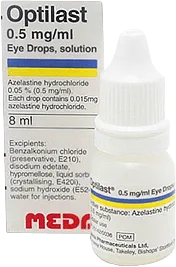
Images are for illustration purposes only.
Optilast Eye Drops
Available size:
Price £12.99
Expected Delivery: Tuesday, 30 December 2025
Why choose Click Pharmacy?
- Rated 'Excellent' on Trustpilot
- UK Registered Pharmacy
- Price Match Guarantee
GPhC Internet Pharmacy Registration
UK Pharmacy Registration Number 9011460
Optilast eye drops are used for eye symptoms caused by allergies. The symptoms may include itchiness in the eyes, redness of the eyes, watery eyes, blurred vision, soreness and swollen eyes. These symptoms may be caused by hay fever, allergy to dust mites, animals, pollen, or extreme weather conditions. Optilast works instantly and relieves the symptoms for up to 24 hours.
This medication is an antihistamine thanks to its active ingredient called Azelastine hydrochloride 0.05%. Azelastine is an antiallergic (antihistamine) that controls the release of histamine (causes symptoms of allergy) from mast cells. This reduces the inflammation of the eyes and calms the symptoms.
Patient Information Leaflet
Always read the patient information leaflet before starting your treatment. The patient information can be found here
Optilast Eye Drops are suitable for adults and children over the age of 12. Use 1 drop into each eye twice a day. If necessary, you can increase it to 4 times a day. Do not use it for more than 6 weeks.
-
Thoroughly wash and dry your hands before use.
-
Gently wipe your eyes with a clean soft cloth or a tissue.
-
Sit comfortably and tilt your head back.
-
Gently pull your lower eyelid down.
-
Carefully place the bottle tip near your waterline.
-
Squeeze a drop into your eye and release your lower eyelid.
-
Close your eyes for a moment and slowly blink your eyes a few times to evenly spread the drop across the surface of your eye
-
Repeat this for your other eye.
-
Store at room temperature.
-
Keep it out of reach of children.
-
For external use only.
-
Discard the bottle after 28 days of opening.
-
Do not use it for too long as it can exacerbate the condition.
-
If you experience eye pain, changes in vision, or increased soreness after use, stop using and consult your doctor.
Optilast eye drops contains the following ingredients:
The active ingredient is azelastine hydrochloride, the equivalent of 0.05mg/ml (0.05%)
The inactive ingredients include benzalkonium chloride (preservative), disodium edetate, hypromellose, sorbitol, (crystallizing) sodium hydroxide, and water for injections.
Optilast Reviews
Expected Delivery: Tuesday, 30 December 2025